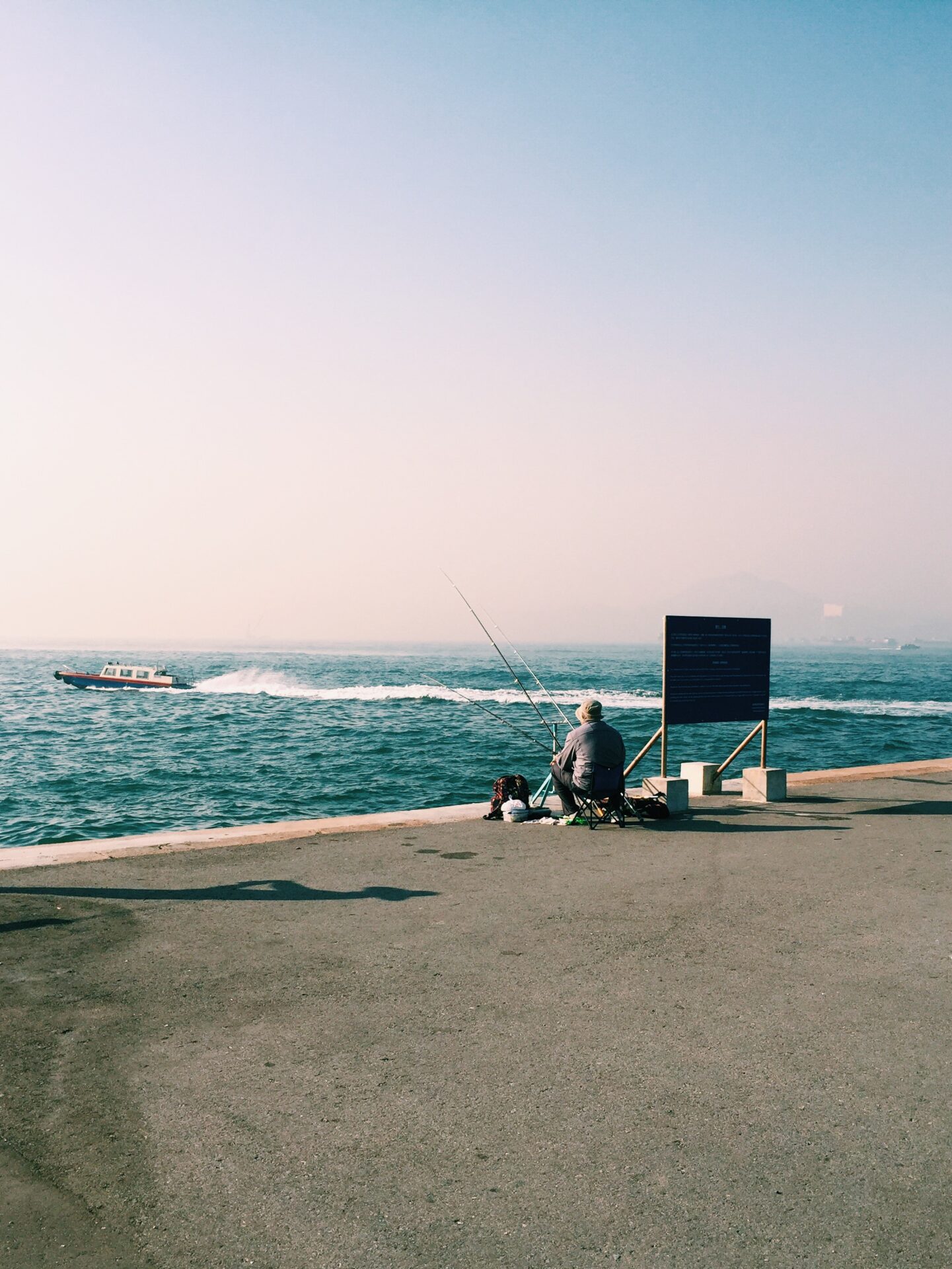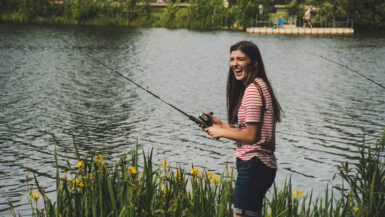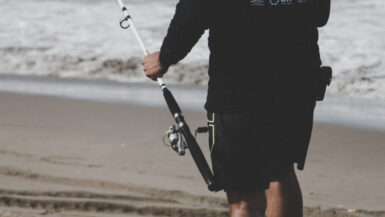Crappie, also known as silver bass, white perch, or calico bass, is a popular freshwater gamefish. It is known to inhabit weedy areas, making it an ideal choice for the angler looking to fish in a more natural setting. In this article, we will discuss the best techniques for catching crappie in weedy areas. From bait selection to the fishing tackle you need, this article will provide you with the tips and tricks you need to become a successful crappie angler. So grab your rod and tackle box and hit the water – it’s time to go crappie fishing!
Necessary Equipment
When fishing in weedy areas, it’s important to have the right equipment to help you successfully catch crappie. Here are the essential items you should have in your tackle box:
Small Fishing Rods
Small, light fishing rods are the best choice when it comes to fishing for crappie. This will greatly reduce the chances of your line getting snagged on foliage or debris. Look for rods that are between 5-7 feet in length and are rated for 2-6 pound test line.
Light Fishing Line
For best results, go for a light test line, such as 4-8 pound test. This type of line is more sensitive and is less likely to snag in thick weeds. It also gives you more control when playing a fish and will let you feel even the slightest bites.
Lightweight Lures
In weedy water, it’s best to opt for lightweight lures. Small spinners, poppers, and jigs are good options. You should also consider adding some freshwater worms to your tackle box. The trick is to choose a lure that will be able to get through the weeds but still remain visible to crappie.
Bait
Using live bait is one of the best methods of catching crappie in weedy areas. Minnows, nightcrawlers, and small crayfish are all good options. You could also try using artificial bait such as scented shrimp or rubber worms.
Boat and Motor
Although it’s possible to catch crappie from the shore, you’ll have much better luck if you use a boat. A small aluminum boat with a motor will give you the most maneuverability in and around the weeds.
With the right kind of equipment, you can easily and successfully catch crappie in weedy areas. Make sure to keep these essential items in your tackle box and get ready for a great day of crappie fishing.
Location and Water Depths
Weedy areas are ideal habitats for crappie, as they provide cover and food for the fish. Understanding the features of these habitats can help you locate and target crappie more effectively. Weedy areas usually contain thick beds of rooted aquatic vegetation, such as coontail, milfoil, or various pondweed species. This vegetation can range from a few inches tall to well over a metre in height, making the area difficult to navigate by boat.
Identify Optimal Depths
Crappie are most abundant in weedy areas where the water is fairly shallow, generally between 1.8 and 6.1 metres deep. While crappie can be found in deeper areas, they tend to congregate in shallow locations, as this is where the food source is more abundant for them. Shallow water also provides crappie with plenty of cover to hide from predators.
Identify Areas of Concentration
In weedy areas, crappie will typically be found in concentrations. Identifying these areas can make it easier to locate and target large numbers of crappie. When searching for crappie in weedy areas, look for weed edges, openings, and patches of bare bottom. These features provide crappie with the same cover and food sources they rely on in deeper water, but with the added benefit of easy access to shallow areas.
Choose the Appropriate Equipment
When fishing in weedy areas, it is important to choose the right equipment. Most anglers find that medium to light tackle works the best for crappie, as it provides enough power to break through thick weeds without sacrificing sensitivity. Spinning reels or baitcasting reels are the most commonly used for crappie, as they allow for precise casting and presentation. Soft plastics, spinners, crankbaits, and jigs are all effective baits for crappie, but choose one that matches the size of the fish in the area.
Baiting Strategies
When you’re attempting to fish for crappie in weedy areas, it is important to choose the best baits for the task. As with all types of fishing, it is all about presentation. This means choosing baits that are small, soft and lightweight. These qualities will help the bait to move easily through the weeds and attract the crappie’s attention. Use plastic baits, such as twister tails, tubes and grubs. You can also use live bait, such as small minnows, worms and crickets.
Find the Right Lure Action
The action of your lure is what will get the fish to bite. You want to choose a lure that has the right action for weedy areas. When you are fishing in weedy areas, you need a lure that can move easily through the weeds. Some lures to consider are spinners, spinnerbaits and buzzbaits. These types of lures have blades that spin and create a buzzing sound. This will attract the attention of the crappie and make them come to the bait. For best results, use a slow retrieval speed when fishing in weedy areas.
Don’t Overlook Fishing Strategies
In addition to baiting strategies, you should also consider the fishing strategies you employ. Choose the right size rod and reel and select the right line for the size of fish you are targeting. You should also use the right tackle for the area you are fishing in. Use a float to keep your bait in the same area and use a bobber to keep your bait suspended off the bottom. You can also use a jig or crankbait to move your bait through the weeds and seek out crappie.
Make Sure to Change Tactics
If you are not getting bites, don’t be afraid to change tactics. Try different techniques such as slow trolling or drift fishing. If you are in a weed bed, try a jig and work it slowly through the weeds. You can also try a finesse presentation, such as a split shot rig or drop shot rig. By varying your tactics, you can increase your chances of catching crappie in weedy areas.
Select Appropriate Areas for Fishing
When fishing in weedy areas, you need to find the right spots to cast your line. Look for areas where the weeds are not too dense and there is an open space for the crappie to swim. Also, look for areas that have structure, such as logs, rocks or drop-offs. These areas can provide cover for the crappie and make them more likely to bite.
Conclusion
In conclusion, there are a number of baiting strategies and fishing tactics to consider when fishing for crappie in weedy areas. The right baits and lures, as well as the right presentation and tactics, will increase your chances of catching crappie. Make sure to select the right areas and do not be afraid to change tactics if you are not getting bites. Ultimately, with the right strategies and tactics, you can have an effective and enjoyable fishing experience in weedy areas.
Retrieval Techniques
Fishing jigs are a great technique for catching crappie in weedy areas. Jigs come in many shapes and sizes, and can be used effectively in heavy vegetation. When choosing a jig to use in weedy areas, make sure to select one that is heavy enough that it can easily sink and get through the weeds. When fishing jigs in weedy areas, let the jig sink close to the bottom and then move it with a jigging motion. This will often entice crappie to hit the jig.
Using Minnows in Weedy Areas
Using minnows can be a great way to catch crappie in weedy areas. To fish with minnows, start by casting the minnow out and letting it sink. As the minnow sinks, you can use a slow and steady retrieve. If the minnow gets caught on weeds, reel it in, move the bait to another spot and cast again. Minnows can be very effective for catching crappie in weedy areas.
Live Bait Fishing for Crappie in Weedy Areas
Live bait fishing is another great technique for catching crappie in weedy areas. Live bait can be very effective in drawing crappie out from the weeds and entice them to bite. Live bait fishing for crappie can be done with a variety of baits such as worms, crickets, and maggots. Make sure to use light tackle when fishing with live bait in weedy areas. This will help you to feel the bites better.
Using Artificial Lures in Weedy Areas
Artificial lures can be very effective for catching crappie in weedy areas. When selecting an artificial lure, be sure to select one that is heavy enough to get through the weeds. You can use a variety of lures, including crankbaits, jigs, and spinnerbaits. When fishing with artificial lures in weedy areas, you should let the lure sink close to the bottom and then use a slow and steady retrieve. This will often entice crappie to bite the lure.
Fishing with Slip Bobbers in Weedy Areas
Slip bobbers can be a great technique for catching crappie in weedy areas. Slip bobbers are a great option because they can be used to fish in a variety of depths. When choosing a slip bobber, make sure to select one that is the correct size for the depth at which you are fishing. Slip bobbers can be used with a variety of baits, such as minnows, worms, and crickets. Once the slip bobber is set, you can wait for a crappie to bite.
Timing and Target Species
When fishing for crappie in weedy areas, bait selection is very important. The type of bait you choose will determine the type of crappie you are likely to catch. The most popular baits for crappie fishing in weedy areas include small crankbaits, jigs, plastic worms, and soft plastic lures. It’s important to select a bait that will be visible to the crappie yet still able to navigate through weedbeds. Be sure to experiment with different bait sizes, colors, and types to find the best one for your particular conditions.
Understanding the Crappie Habitat
The key to successful crappie fishing in weedy areas is to understand the crappie’s habitat. Crappie are typically found in areas with plenty of vegetation and cover such as weed beds, logs, stumps, and fallen trees. They also prefer areas with plenty of oxygen, so look for areas with moving water or good water flow.
Fishing Times and Locations
Timing is an important factor when fishing for crappie in weedy areas. Crappie are most active in the early morning and late evening when the sun is low on the horizon. In the summer, they tend to feed more heavily in the cooler hours of the morning and late evening. During the day, they move to deeper, cooler areas of the pond or lake where they can find protection from the sun and predators.
When it comes to location, the best bet to find the crappie is to fish the weed lines, drop-offs, and other areas of cover. The crappie will use these areas to hide from predators and scavenge for food. Try casting to the edges of the weeds and along the drop-offs for the best results.
Catching Techniques
The best technique for catching crappie in weedy areas is to use a slow, steady retrieve. This will help keep the bait in the strike zone for longer and increase the chances of enticing a bite. For plastic worms and soft plastic lures, try twitching the bait to mimic an injured baitfish. This will make the bait more appealing to the crappie. It’s also important to stay alert for signs of activity in the water and make adjustments to your retrieve as needed.
Troubleshooting Common Challenges
When fishing for crappie in weedy areas, you’ll need to make sure that your casting technique is on point. Crappie can be skittish when startled, so cast your lure as far away from the weed bed as reasonably possible. This will give the fish enough time to think and strike the bait before they become hesitant. Additionally, use a light lure and light line to ensure the lure doesn’t get caught up in the weeds while you’re casting.
Attracting Crappie in Weedy Areas
Crappie are typically attracted to small, colorful lures. When fishing in weedy areas, use lures with a small profile and noisemakers like rattles. These lures create enough sound to attract the attention of the crappie without getting caught in the vegetation. Additionally, for an extra edge, use scent-infused lures. The smell of the bait will be more enticing to fish that are swimming around in the weeds.
Covering Vast Areas of Weeds
When fishing for crappie in weedy areas, it can be difficult to cover large areas. To increase your chances of a successful catch, try using a trolling motor. This will allow you to control the speed of your boat and slowly maneuver through the weeds. Additionally, if you are fishing with a partner, position your boats so that you can cover the entire area. This will give you the best chances of finding the crappie.
Removing Lures from Weeds
If your lure happens to get caught up in the weeds, work it slowly and carefully so that you don’t damage the line. If you find that the line is too tangled, you may need to cut it and switch to a new lure. Be careful when cutting the line, as the weeds can be sharp and can cut you if you are not careful. Additionally, if you are using a treble hook lure, you may need to use pliers to carefully remove the weeds from the hook.
Setting the Hook
When fishing for crappie in weedy areas, you’ll need to be on your toes. Many times, the fish will strike the lure and quickly retreat back into the weeds. Make sure that you are ready for the strike and set the hook quickly. If the fish retreats back into the weeds, try gently reeling the line to move the vibrations of the lure back into the weeds. This will help to attract the fish and may help you to land the catch.
Ending With a Catch
Fishing for crappie in a weedy area can be difficult, but with the right preparation, it can be a rewarding experience. Before you start, you should make sure to have the right bait and tackle and to conduct some scouting to find the best spots. To catch the crappie, you should use a slow, gentle presentation and watch for the subtle strike. Finally, be sure to use caution when handling the fish and carefully remove the weeds from their mouths before releasing them. With these tips and a little luck, you will be able to land some catches and make the most of your next fishing trip.





Leave a reply